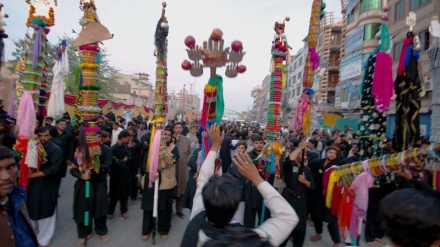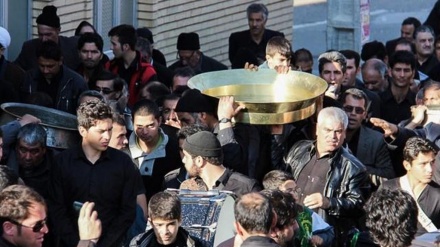Muharram mourning traditions in different lands - 39
Welcome to the 39th part of the series titled “Muharram Mourning Traditions in Different Lands” that we started broadcasting as of October 15 on a daily basis, to commemorate the heartrending tragedy of Karbala, and the martyrdom of Imam Husain (AS), the grandson of Prophet Mohammad (SAWA).
In this series, which delves into the mourning traditions associated with the Immortal Epic of Ashura, we have been focusing on the various norms prevalent in different towns and cities of Iran for commemorating the heartrending tragedy of Karbala, after having dwelt on the history of mourning in different countries of the world for Imam Husain (AS). Today we talk about the tradition of “Ta'ziya” or religious drama in the Islamic Republic of Iran. “Ta'ziya” or “Ta’ziyat” in Persian, which means comfort, condolence, comes from the roots of “Aza” which is Arabic for mourning. In Iran “Ta’ziya Khwani”, means a religious play based on the historical, tragic and epic events of Karbala and the martyrdom of Imam Husain (AS). It is also known as "Shabih Khwani".
According to scholars, the performing of “Ta’ziya” or “Shabih Khwani” dates back more than a thousand years ago to the time of the Buwaiyhid or Daylamite dynasty of Iranian origin that ruled Iran, Iraq, and Oman for over a hundred years. It changed its form to the current style at the time of Safavids Emperors, some four to five hundred years back, and from Iran and Iraq spread to other lands, such as Bahrain, southern coast of the Arabian Peninsula, Greater Syria, Ottoman Turkey, and the Caucasus. Ta’ziya reached its peak during the century and 30-year rule of the Qajars. Early Iraqi historians such as Ibn Jawzi and Ibn Atheer were the first historians who gave reports of religious gatherings of Shi’a Muslims during the rule of Daylamite dynasty; marching in the streets of Baghdad and observing Azadari or mourning for the martyred grandson of Prophet Mohammad (SAWA).
They write that the markets were closed and all business stopped the day of Ashura, as public processions marched on the streets, reciting Nowha or elegies and beating their heads and chests in grief. They mention that the Shi'a Muslims of the locality of Karkh in Baghdad made the Shabih play of the events of Karbala like a drama. The Seljuqs who replaced the Daylamites in Iran and Iraq, suppressed such ceremonies, which were revived by the Safavids. Among European travelers, the French Jean-Baptiste Tavernier has mentioned the performance of Shabih plays about events of Karbala and their display in mourning marches in front of Shah Safi at Naqsh-e Jahan Square in Isfahan. He has described saddled horses of the martyrs and symbolic coffins being carried.
During the Qajarid era, the British military and political agent in Iran, Justinian Morier, in his first logbook, has mentioned performance of three sessions of Ta'ziya before Fath Ali Shah: Ta'ziya plays of the children of Muslim bin Aqeel, the Bazaar-e Shaam or the Marketplace of Damascus through which the Omayyad paraded the survivors of the Karbala tragedy, and the martyrdom of Imam Husain (AS). These were held on the 8th, 9th and 10th of Muharram. The 50-year rule of Naser od-Din Shah, was the period of the development and glory of Ta’ziya in Iran, especially in Tehran. The king showed profound interest about performing Ta'ziya and in every Muharram. If he was in Tehran, he would go to government Takiyyas for watching Shabih Khani, and if he was out of Tehran, he would go to local Takiyyas.
He encouraged government agents and officials responsible in holding Ta'ziya sessions to make the sessions and plays more attractive. Reza Khan Pahlavi, whom the British installed as king in Tehran, suppressed Ta’ziya and all other religious ceremonies, which after his exile from Iran, were gradually revived, and are now held all over Iran in their current form, enabling onlookers to realize what tragic events happened in Karbala. One can see this popular form of religious plays throughout Iran, in virtually every city and town, in the months of Muharram and Safar. After the victory of the Islamic Revolution in Iran in 1979, this form of religious plays were further developed and far more people were given the opportunity to watch or to actively take part in Ta'ziya.
In Ta'ziya, there are three things which are fundamentally important, that is, words, doleful music, and the movement of the actors. Poetry and music are central to Ta'ziya, and the movement of actors must be in step, and in tune with the music and poetry of this play. Much of the words spoken by actors in Ta'ziya, is either poetry or has a poetical feel about it. Generally speaking, actors in Ta'ziya use a mixture of poetry and every-day language used by ordinary people, so that the majority of people have no trouble understanding what the actors are trying to convey. It is also true to say that clothes worn by actors and some of the instruments or props used by the actors are colour-coded.
By this we mean that actors who play the part of good characters, or men of God, that is, the part of the martyred Imam, his family members and loyal companions, generally wear green clothes. So green represents Islam, righteousness, and sanctity. On the other hand, actors who play the parts of bad or evil characters, such as Yazid, the evil and ruthless tyrant, or his henchmen, generally wear red clothes. So red is the colour which represents blood, bloodshed, evil, ruthlessness, hypocrisy and deceit. This is all very symbolic, and the two colours of green and red essentially signify two ways of thinking, two different mindsets, since historically green was the colour of the Prophet’s Clan the Bani Hashem, and Red was the colour of the Omayyad usurpers. In addition to this, horses belonging to good characters are always white in this form of religious drama, whereas the horses belonging to bad or evil characters (i.e. the enemies of Islam) are invariably black in colour. So white and black also represent good and bad (or righteousness and falsehood) respectively.
Another important point about Ta'ziya is that people from all walks of life come to watch it, and that all the spectators are considered equal. Very often, the actors come and sit among the audience, and freely chat with the audience and spectators during the performance. Thus, it is fair to say that the spectators are actually part of the performance!! Almost always a close bond – an emotional bond – develops between the spectators or audience, and the actors. The director or manager of this religious play, called “Ta'ziya Gardaan” in Persian, is usually someone with decades of experience in acting – someone who has played both good and evil characters in Ta'ziya. Such a person, with a wealth of experience in Ta'ziya, is well-qualified to direct and manage a religious drama. An essential rule of acting in Ta'ziya, is that the actors must always be aware, and keep in mind the fact that not every person can ever portray an Imam!!
In fact, it is true to say that all actors who perform in Ta'ziya revere the Ahl al-Bayt, and in particular, Imam Husain (AS). This is why, for example, the actor that plays the part of "Shemr", the evil and Godless commander of Yazid's army who decapitated the Prophet’s grandson, always cries in Ta'ziya, and always acknowledges the virtues of Imam Husain (AS).
MD/AS/ME


